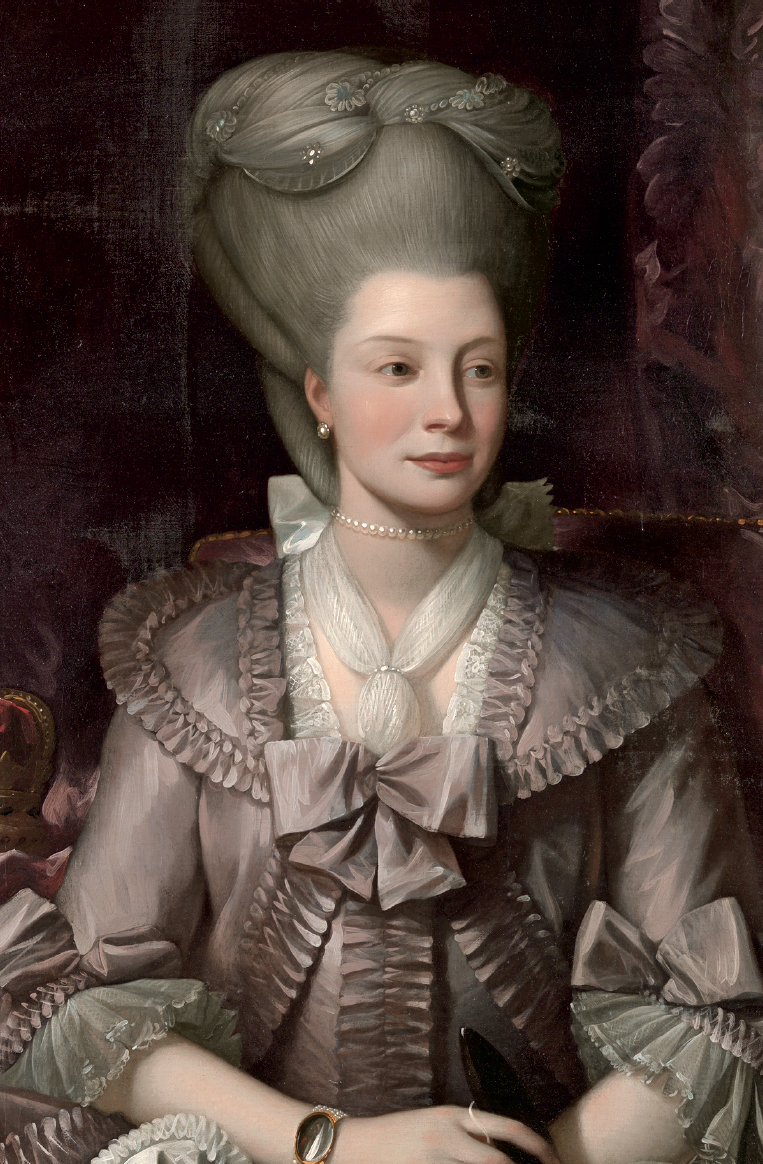
We begin our hairstyling adventure in 1750, a time when low, un-cushioned hairstyles were en vogue in both England and France. Though these hairstyles greatly differed between the two cultures, hairstyling had not significantly changed for decades. We’ve chosen this mid-century date as our origin point, illustrating throughout this section the transition from low styles to hair of great enormity in a thirty-year span.
Entering the 1760s, coiffure begins to rise. Hair as an art form emerges in France, driven by Legros de Rumigny, hairdresser to the court of Louis XV and particularly Madame de Pompadour. Legros’s signature style was highly powdered, complex and sculptural, adorning the heads of aristocratic women with buckles, shell curls, frizzes, latticework chignons and an array of headdresses. [1]
Legros’s influence was widespread, particularly after the publication of his book L’Art de la Coëffure des Dames Françoises in 1768, which gave detailed descriptions of tools, products, methods and haircuts, along with twenty-eight color illustrations of his coiffures with descriptions. [2]
As the 1770s open, a significant change occurs in hairdressing. Hair had already been ascending gradually but would take on new heights with the appointment of Léonard Autié as hairdresser to Marie Antoinette in 1772. Léonard came from the theatrical world and first gained notoriety for his fanciful headdress at the Théâtre de Nicolet. [3] His flair for the dramatic perfectly aligned with Marie Antoinette’s desire to make her mark through fashion, and together they introduced the vogue for what we think of today as iconic eighteenth-century hair.
As the Queen always needed to be the trendsetter, Léonard obliged with ever more invention and skill. Here is where we first see enormous cushions such as the donut (here) and ski slope in use, topped with feathers, flowers and the pouf, yet another Léonard creation. All of Europe and the Colonies responded to these impressive headdresses, and the fashions even trickled down to the lower classes, [4] driven by the widespread distribution of fashion magazines, one of which, Journal des Dames, was managed by Léonard himself with the blessing and financial backing of Marie Antoinette. [5]
The growing extravagance and skill in French hairdressing made its way to England, with evidence in fashion plates and descriptions of hairstyles [6] showing and describing a correlation between Legros’s and Léonard’s work and the wider world. Powder becomes more popular and regularly worn in England, creating the texture and pliability needed for the fashionably high hairstyles. [7] However, through the beginning of the 1770s many English-women still preferred a simpler “English” style with little to no powder used. This difference is important when deciding how to style yourself for your 1750s–1770 look—do you want to look more French or English? [8]
Matthew Darly. The Back-Side of a Front Row. 1777. Jan. 1. Photograph. Library of Congress. https://www.loc.gov/item/2006681194/.

Rapilly. Headdress Engraving. 18th Century. The Los Angeles County Museum of Art. www.lacma.org. M.83.194.6.

Benjamin West, 1738–1820. Queen Charlotte. 1777. Yale Center for British Art, Paul Mellon Collection. B1977.14.115.
It was around the late 1760s and early 1770s that hair cushions came into fashion. As James Stewart recalls in 1782, “It is not above 12–13 years since cushions were first wore, then they appeared like an exceeding small women’s pin-cushion; but from this cushion, the plan of the hair has ever since depended on. The hair has been wore higher since, wider, narrower, lower, heavier, lighter, more transparent, more craped, smoother, &c. &c. With one curl, two curls, three curls, four curls, five curls, and no curls at all, but all from the same foundation.” [9]
In this section, we take you from the 1750s through Legros’s influence in late ’60s styling, all the way through the 1770s high hair. We provide instructions for dressing the hair as well as appropriate hair decorations, including one heck of a pouf. This is a fun and frivolous period of hairstyling, so don’t be afraid to go all out. An extravagant coiffure is just the thing to top off your beautiful ensemble and impress the heck out of everyone, just as Marie Antoinette intended.